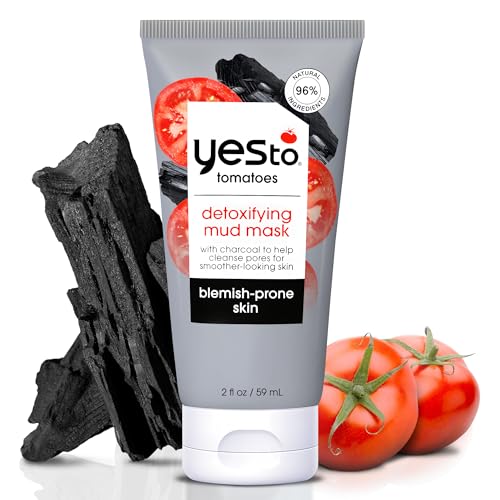
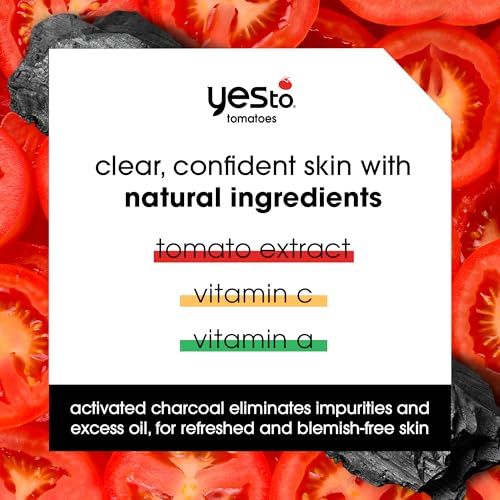
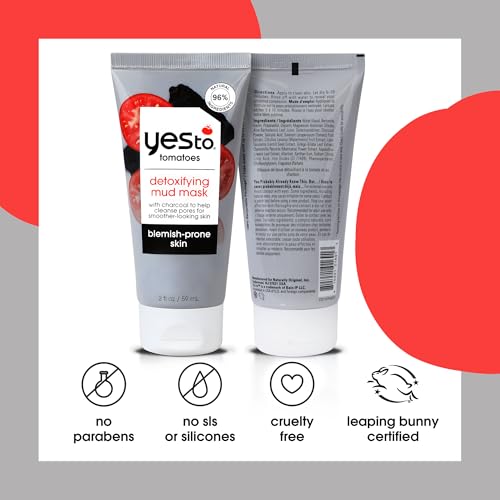
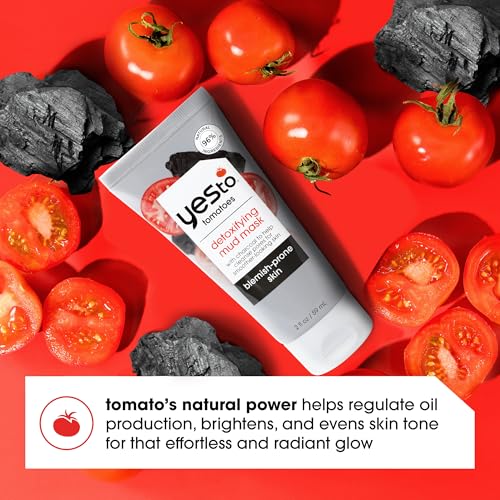
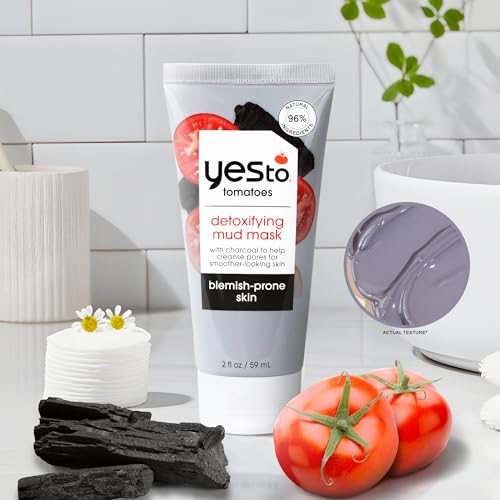
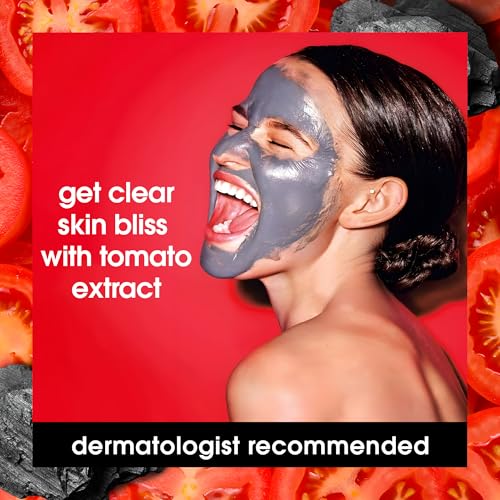
Yes To Tomatoes Charcoal Mud Mask - Draws Out Impurities, Salicylic Acid - 2.006 Fl Oz


Carbon
High RiskCarbon is an amorphous form of elemental carbon commonly used in various products. It serves multiple functions, including acting as a pigment, filler, or adsorbent, depending on the formulation. Its versatile applications span across personal care, cosmetics, and other industries.
Sustai Insights
Carbon has functional benefits such as enhancing product texture and stability. It is generally considered low in health risks, with minimal concerns regarding carcinogenicity, allergies, and reproductive toxicity. However, its use is subject to high restrictions due to regulatory concerns about safety and environmental impact, including potential pollution and bioaccumulation. The overall risk associated with carbon is high, necessitating careful consideration in product use. Alternatives like plant-based pigments or biodegradable fillers may offer safer options.
Salicylic Acid
High RiskSalicylic acid is a naturally occurring and synthetic compound primarily used in skincare products for its ability to exfoliate skin, unclog pores, and treat acne. It is a beta hydroxy acid (BHA) that penetrates the skin to effectively reduce inflammation and promote cell turnover.
Sustai Insights
Salicylic acid is recognized for its effective acne treatment properties and ability to enhance skin absorption, making it beneficial in various formulations. However, its use is subject to restrictions due to potential adverse health effects such as skin irritation and enhanced absorption risks. Regulatory bodies have cautioned against high concentrations, marking it as a high-risk ingredient. Special consideration should be given to sensitive populations, and safer alternatives like glycolic acid may be explored to minimize risks.
Sodium Hydroxide
High RiskSodium hydroxide is a highly caustic and reactive inorganic compound commonly used as a pH adjuster in various products. It is effective in neutralizing acids and plays a role in the production of soaps and detergents.
Sustai Insights
Sodium hydroxide serves essential functions, particularly in adjusting pH levels, but poses significant health risks, including skin and eye irritation. It is subject to high usage restrictions due to its corrosive nature. Environmental concerns include its potential to pollute water sources and contribute to ecosystem damage. Regulatory bodies have imposed strict guidelines on its use, indicating a high-risk profile for products containing this ingredient. Safe handling practices are crucial, and alternatives include milder pH adjusters, emphasizing the need for caution in its application.
Phenoxyethanol
Medium RiskPhenoxyethanol is a preservative used in cosmetics and personal care products to prevent microbial growth and extend shelf life. It is commonly found in formulations such as lotions, creams, and serums.
Sustai Insights
Phenoxyethanol serves effectively as a preservative, ensuring product stability and safety by inhibiting microbial growth. It is considered to have low health risks regarding carcinogenicity, allergies, and reproductive toxicity. However, moderate use restrictions exist, and regulatory bodies have advised caution in specific applications. Environmental concerns include its potential as a pollutant, although it is not highly bioaccumulative. Overall, the ingredient presents a medium risk level, with safe usage practices recommended and alternative preservatives available for those seeking greener options.
Bentonite
Medium RiskBentonite is a native hydrated colloidal aluminum silicate clay that is utilized in various products for its binding, thickening, and absorbent properties. It serves functions such as stabilizing emulsions and enhancing texture in formulations.
Sustai Insights
Bentonite offers functional benefits as a thickening agent and stabilizer, and it is often sourced sustainably. It has low concerns for carcinogenicity, allergies, and developmental toxicity, but moderate use restrictions exist. Environmental risks include potential pollutant characteristics. Regulatory bodies have noted these restrictions, suggesting careful usage. Overall, the risk level is assessed as medium, and users are advised to consider alternatives like kaolin clay for similar properties.
Kaolin
Low RiskKaolin is a clay mineral composed of hydrated aluminum silicate. It is commonly used in various products for its absorbent properties, acting as a thickener, filler, and anti-caking agent in cosmetics, pharmaceuticals, and food applications.
Sustai Insights
Kaolin offers functional benefits such as effective absorption and thickening, making it valuable in personal care and industrial products. It is generally considered safe, with low concerns related to carcinogenicity, allergies, and reproductive toxicity. Environmental risks are minimal, as it is not known to be a pollutant or bioaccumulative. Regulatory bodies impose few restrictions, underscoring its low-risk profile. Safe usage practices are recommended, and while alternatives exist, kaolin remains a low-risk option in its applications.
Allantoin
Low RiskAllantoin is a naturally occurring nitrogenous compound found in various plants and animals. It is commonly used in cosmetic formulations for its soothing and moisturizing properties, as well as its ability to promote skin cell turnover and healing.
Sustai Insights
Allantoin offers functional benefits such as skin soothing, hydration, and promoting cell regeneration. It is generally recognized as safe, with low concerns regarding carcinogenicity, allergies, and reproductive toxicity. Environmentally, it poses minimal risks, being biodegradable and sustainably sourced. Regulatory bodies do not impose significant restrictions on its use. Overall, the risk level associated with allantoin is low, making it a favorable ingredient in personal care products.
Aspalathus Linearis (Rooibos) Extract
Low RiskAspalathus linearis extract is derived from the leaves of the rooibos plant, commonly used in beverages and cosmetic products for its antioxidant properties and potential skin benefits. It is known for its high content of flavonoids, which contribute to its functional role in formulations.
Sustai Insights
Aspalathus linearis extract offers functional benefits such as antioxidant properties and skin soothing effects, making it a valuable ingredient in cosmetics. It is sustainably sourced and poses low health risks, including negligible concerns for carcinogenicity and allergies. Environmental risks are minimal, with no significant pollutants or bioaccumulation issues. Regulatory assessments indicate no restrictions, reflecting its safe use in various applications. Overall, it is assessed as low risk, with no substantial adverse effects noted, making it a suitable choice for consumers.
Chamomilla Recutita (Matricaria) Flower Extract
Low RiskChamomilla recutita (Matricaria) flower extract is derived from the flower of the chamomile plant. It is commonly used in cosmetic products for its soothing properties and as an anti-inflammatory agent. This extract is valued for its potential to calm skin irritations and enhance overall skin appearance.
Sustai Insights
Chamomilla recutita (Matricaria) flower extract is recognized for its soothing and anti-inflammatory benefits, making it effective in skincare formulations. It is sustainably sourced and not associated with significant health risks, such as carcinogenicity or allergenic potential, resulting in a low-risk profile. Environmental concerns are minimal as it does not contribute significantly to pollution. Regulatory bodies impose few restrictions on its use, further supporting its safety. However, users should practice standard safety measures, particularly if they have known sensitivities. Overall, it is a low-risk ingredient with favorable attributes.
Water
Low RiskWater is a clear, colorless liquid essential for various biological processes. It serves as a solvent in formulations, facilitating the dissolution of other ingredients and enhancing product texture and application. Additionally, water plays a crucial role in hydration and is a key component in many cosmetic and personal care products.
Sustai Insights
Water is an effective solvent and hydrator, contributing to the texture and efficacy of formulations. It is biodegradable and generally regarded as safe, with low concerns regarding carcinogenicity, allergies, and reproductive toxicity. However, excessive water usage can lead to environmental concerns, particularly regarding resource depletion. Regulatory bodies do not impose restrictions on water use in cosmetics. Overall, the risks associated with water are low, making it a safe and essential ingredient.
Propanediol
Low RiskPropanediol is a glycol compound commonly used in cosmetic and personal care products as a solvent, humectant, and skin-conditioning agent. It serves to enhance the texture and moisture retention of formulations, contributing to overall product efficacy.
Sustai Insights
Propanediol offers functional benefits such as effective moisture retention and improved product application. It is considered low-risk in terms of health concerns, with minimal associations with carcinogenicity, allergies, or reproductive toxicity. Environmentally, it has low pollutant potential and is not bioaccumulative. Regulatory bodies have not placed restrictions on its use. Despite concerns regarding enhanced skin absorption and potential endocrine disruption, the overall assessment indicates low risk. Safe usage practices should be followed, and alternatives like glycerin or other plant-based humectants can be considered.
Lens Esculenta (Lentil) Seed Extract
Low RiskLens esculenta (lentil) seed extract is derived from lentil seeds and is commonly used in cosmetic formulations. It serves as a source of antioxidants and may contribute to skin conditioning and moisturizing properties in various personal care products.
Sustai Insights
Lens esculenta (lentil) seed extract offers functional benefits as a skin-conditioning agent, harnessing antioxidant properties. It poses low health risks, with no significant concerns regarding carcinogenicity, allergies, or reproductive toxicity. Environmentally, it is not associated with pollution or bioaccumulation. Regulatory status indicates no current restrictions. Overall, this ingredient is assessed as low risk, making it a favorable choice in formulations.
Aloe Barbadensis (Aloe Vera) Leaf Extract
Low RiskAloe vera leaf extract is produced from the succulent leaves of the Aloe barbadensis plant. It is commonly used in cosmetic formulations for its moisturizing and soothing properties, making it a popular ingredient in skincare and personal care products.
Sustai Insights
Aloe vera leaf extract offers several functional benefits, including hydration and skin soothing effects, which are well-supported by scientific literature. It is considered to have a low risk for common health concerns such as carcinogenicity, allergies, or reproductive toxicity. Environmentally, it poses minimal risks, with no significant pollutant potential or bioaccumulation reported. Regulatory bodies have not imposed major restrictions, although verified products should not contain certain contaminants. Overall, this ingredient is assessed as low risk, with safe usage practices and the availability of alternative soothing agents if desired.
Citrullus Lanatus (Watermelon) Fruit Extract
Low RiskCitrullus lanatus (watermelon) fruit extract is derived from the fruit of the watermelon plant and is commonly used in cosmetic and personal care products for its hydrating and soothing properties. It primarily serves as a moisturizing agent and may provide additional benefits related to skin health.
Sustai Insights
Citrullus lanatus extract offers functional benefits such as moisturizing and soothing effects on the skin, contributing to product efficacy. It is sustainably sourced and generally recognized as safe, with low concerns regarding cancer, allergies, and reproductive toxicity. While there are no significant environmental risks associated with its use, regulatory bodies do not have specific restrictions on this ingredient. Overall, it presents a low risk profile, making it a suitable choice in formulations.
Xanthan Gum
Low RiskXanthan gum is a polysaccharide, a sugar-based compound produced by the fermentation of glucose or sucrose. It is commonly used as a thickening agent and stabilizer in various food and cosmetic products due to its ability to improve texture and prevent ingredient separation.
Sustai Insights
Xanthan gum serves effectively as a thickener and stabilizer, enhancing product texture and consistency. It is biodegradable and typically derived from renewable sources, supporting sustainability efforts. Health risks are minimal, with low concerns regarding carcinogenicity, allergies, and reproductive toxicity. Environmental impact is similarly low, posing no significant hazards. Regulatory agencies, including the FDA, regard it as safe for use, with no significant restrictions. Overall, xanthan gum is assessed as low risk, making it a suitable ingredient in formulations.
Vegetarian Glycerin
Low RiskVegetarian glycerin, also known as glycerol, is a colorless, odorless, and viscous liquid derived from plant sources. It is primarily used as a humectant, solvent, and emollient in various personal care products, helping to retain moisture and improve texture.
Sustai Insights
Vegetarian glycerin offers functional benefits as an effective humectant, promoting hydration and skin smoothness. It is biodegradable and typically sustainably sourced. Health risks associated with glycerin are low, with no significant concerns for carcinogenicity, allergens, or reproductive toxicity. Environmental risks are minimal, and it is not subject to major regulatory warnings. Overall, the risk level for this ingredient is low, making it a safe choice in formulations. Safe usage practices include ensuring proper concentrations in products, and alternatives such as propylene glycol exist but may have differing properties.
Cucurbita Pepo (Pumpkin)
Low RiskCucurbita pepo (pumpkin) is a gourd belonging to the Cucurbitaceae family, commonly cultivated for its edible fruit and seeds. It is often utilized in food products and cosmetics for its moisturizing properties and as a source of vitamins and antioxidants.
Sustai Insights
Cucurbita pepo exhibits functional benefits, serving as a moisturizer and a source of vitamins A and C, contributing to skin nourishment. It is sustainably sourced and biodegradable. Health risks are low, with minimal concerns regarding carcinogenicity, allergens, or toxicity. Environmental hazards are also low, with no significant pollutant potential. Regulatory bodies have not imposed restrictions on its use. Overall, the risk level associated with this ingredient is low, making it a safe choice in formulations.
Galactoarabinan
Low RiskGalactoarabinan is a polysaccharide obtained from the larch tree and is commonly used in cosmetic and personal care products. It acts as a humectant and thickening agent, contributing to product texture and moisture retention.
Sustai Insights
Galactoarabinan serves functional benefits as a humectant and thickening agent, enhancing product texture while retaining moisture. It is biodegradable and derived from renewable sources, supporting sustainability. Health risks are low, with no significant concerns regarding carcinogenicity, allergies, or reproductive toxicity. Environmental risks are minimal, as it does not contribute significantly to pollution or bioaccumulation. Regulatory status is favorable, with no current restrictions. Overall, this ingredient is assessed as low risk, making it a suitable choice in formulations.
Alumina Magnesium Metasilicate
Low RiskAlumina magnesium metasilicate is an inorganic compound commonly used in cosmetics and personal care products. It primarily functions as an absorbent and anti-caking agent, enhancing product texture and stability.
Sustai Insights
Alumina magnesium metasilicate offers functional benefits by improving product texture and preventing clumping. Health risks are minimal, with low concerns regarding carcinogenicity, allergies, and reproductive toxicity. Environmental risks are also low, as it does not significantly contribute to pollution or bioaccumulation. Regulatory status indicates no significant restrictions, lending to an overall low-risk assessment. Safe usage practices include adhering to recommended concentrations, with alternatives like silica available if desired.
Kaolin
Low RiskKaolin is a clay mineral composed of hydrated aluminum silicate. It is commonly used in various products for its absorbent properties, acting as a thickener, filler, and anti-caking agent in cosmetics, pharmaceuticals, and food applications.
Sustai Insights
Kaolin offers functional benefits such as effective absorption and thickening, making it valuable in personal care and industrial products. It is generally considered safe, with low concerns related to carcinogenicity, allergies, and reproductive toxicity. Environmental risks are minimal, as it is not known to be a pollutant or bioaccumulative. Regulatory bodies impose few restrictions, underscoring its low-risk profile. Safe usage practices are recommended, and while alternatives exist, kaolin remains a low-risk option in its applications.
Carbon
High RiskCarbon is an amorphous form of elemental carbon commonly used in various products. It serves multiple functions, including acting as a pigment, filler, or adsorbent, depending on the formulation. Its versatile applications span across personal care, cosmetics, and other industries.
Sustai Insights
Carbon has functional benefits such as enhancing product texture and stability. It is generally considered low in health risks, with minimal concerns regarding carcinogenicity, allergies, and reproductive toxicity. However, its use is subject to high restrictions due to regulatory concerns about safety and environmental impact, including potential pollution and bioaccumulation. The overall risk associated with carbon is high, necessitating careful consideration in product use. Alternatives like plant-based pigments or biodegradable fillers may offer safer options.
Phenoxyethanol
Medium RiskPhenoxyethanol is a preservative used in cosmetics and personal care products to prevent microbial growth and extend shelf life. It is commonly found in formulations such as lotions, creams, and serums.
Sustai Insights
Phenoxyethanol serves effectively as a preservative, ensuring product stability and safety by inhibiting microbial growth. It is considered to have low health risks regarding carcinogenicity, allergies, and reproductive toxicity. However, moderate use restrictions exist, and regulatory bodies have advised caution in specific applications. Environmental concerns include its potential as a pollutant, although it is not highly bioaccumulative. Overall, the ingredient presents a medium risk level, with safe usage practices recommended and alternative preservatives available for those seeking greener options.
Allantoin
Low RiskAllantoin is a naturally occurring nitrogenous compound found in various plants and animals. It is commonly used in cosmetic formulations for its soothing and moisturizing properties, as well as its ability to promote skin cell turnover and healing.
Sustai Insights
Allantoin offers functional benefits such as skin soothing, hydration, and promoting cell regeneration. It is generally recognized as safe, with low concerns regarding carcinogenicity, allergies, and reproductive toxicity. Environmentally, it poses minimal risks, being biodegradable and sustainably sourced. Regulatory bodies do not impose significant restrictions on its use. Overall, the risk level associated with allantoin is low, making it a favorable ingredient in personal care products.
Aspalathus Linearis (Rooibos) Extract
Low RiskAspalathus linearis extract is derived from the leaves of the rooibos plant, commonly used in beverages and cosmetic products for its antioxidant properties and potential skin benefits. It is known for its high content of flavonoids, which contribute to its functional role in formulations.
Sustai Insights
Aspalathus linearis extract offers functional benefits such as antioxidant properties and skin soothing effects, making it a valuable ingredient in cosmetics. It is sustainably sourced and poses low health risks, including negligible concerns for carcinogenicity and allergies. Environmental risks are minimal, with no significant pollutants or bioaccumulation issues. Regulatory assessments indicate no restrictions, reflecting its safe use in various applications. Overall, it is assessed as low risk, with no substantial adverse effects noted, making it a suitable choice for consumers.
Bentonite
Medium RiskBentonite is a native hydrated colloidal aluminum silicate clay that is utilized in various products for its binding, thickening, and absorbent properties. It serves functions such as stabilizing emulsions and enhancing texture in formulations.
Sustai Insights
Bentonite offers functional benefits as a thickening agent and stabilizer, and it is often sourced sustainably. It has low concerns for carcinogenicity, allergies, and developmental toxicity, but moderate use restrictions exist. Environmental risks include potential pollutant characteristics. Regulatory bodies have noted these restrictions, suggesting careful usage. Overall, the risk level is assessed as medium, and users are advised to consider alternatives like kaolin clay for similar properties.
Chamomilla Recutita (Matricaria) Flower Extract
Low RiskChamomilla recutita (Matricaria) flower extract is derived from the flower of the chamomile plant. It is commonly used in cosmetic products for its soothing properties and as an anti-inflammatory agent. This extract is valued for its potential to calm skin irritations and enhance overall skin appearance.
Sustai Insights
Chamomilla recutita (Matricaria) flower extract is recognized for its soothing and anti-inflammatory benefits, making it effective in skincare formulations. It is sustainably sourced and not associated with significant health risks, such as carcinogenicity or allergenic potential, resulting in a low-risk profile. Environmental concerns are minimal as it does not contribute significantly to pollution. Regulatory bodies impose few restrictions on its use, further supporting its safety. However, users should practice standard safety measures, particularly if they have known sensitivities. Overall, it is a low-risk ingredient with favorable attributes.
Water
Low RiskWater is a clear, colorless liquid essential for various biological processes. It serves as a solvent in formulations, facilitating the dissolution of other ingredients and enhancing product texture and application. Additionally, water plays a crucial role in hydration and is a key component in many cosmetic and personal care products.
Sustai Insights
Water is an effective solvent and hydrator, contributing to the texture and efficacy of formulations. It is biodegradable and generally regarded as safe, with low concerns regarding carcinogenicity, allergies, and reproductive toxicity. However, excessive water usage can lead to environmental concerns, particularly regarding resource depletion. Regulatory bodies do not impose restrictions on water use in cosmetics. Overall, the risks associated with water are low, making it a safe and essential ingredient.
Propanediol
Low RiskPropanediol is a glycol compound commonly used in cosmetic and personal care products as a solvent, humectant, and skin-conditioning agent. It serves to enhance the texture and moisture retention of formulations, contributing to overall product efficacy.
Sustai Insights
Propanediol offers functional benefits such as effective moisture retention and improved product application. It is considered low-risk in terms of health concerns, with minimal associations with carcinogenicity, allergies, or reproductive toxicity. Environmentally, it has low pollutant potential and is not bioaccumulative. Regulatory bodies have not placed restrictions on its use. Despite concerns regarding enhanced skin absorption and potential endocrine disruption, the overall assessment indicates low risk. Safe usage practices should be followed, and alternatives like glycerin or other plant-based humectants can be considered.
Lens Esculenta (Lentil) Seed Extract
Low RiskLens esculenta (lentil) seed extract is derived from lentil seeds and is commonly used in cosmetic formulations. It serves as a source of antioxidants and may contribute to skin conditioning and moisturizing properties in various personal care products.
Sustai Insights
Lens esculenta (lentil) seed extract offers functional benefits as a skin-conditioning agent, harnessing antioxidant properties. It poses low health risks, with no significant concerns regarding carcinogenicity, allergies, or reproductive toxicity. Environmentally, it is not associated with pollution or bioaccumulation. Regulatory status indicates no current restrictions. Overall, this ingredient is assessed as low risk, making it a favorable choice in formulations.
Aloe Barbadensis (Aloe Vera) Leaf Extract
Low RiskAloe vera leaf extract is produced from the succulent leaves of the Aloe barbadensis plant. It is commonly used in cosmetic formulations for its moisturizing and soothing properties, making it a popular ingredient in skincare and personal care products.
Sustai Insights
Aloe vera leaf extract offers several functional benefits, including hydration and skin soothing effects, which are well-supported by scientific literature. It is considered to have a low risk for common health concerns such as carcinogenicity, allergies, or reproductive toxicity. Environmentally, it poses minimal risks, with no significant pollutant potential or bioaccumulation reported. Regulatory bodies have not imposed major restrictions, although verified products should not contain certain contaminants. Overall, this ingredient is assessed as low risk, with safe usage practices and the availability of alternative soothing agents if desired.
Salicylic Acid
High RiskSalicylic acid is a naturally occurring and synthetic compound primarily used in skincare products for its ability to exfoliate skin, unclog pores, and treat acne. It is a beta hydroxy acid (BHA) that penetrates the skin to effectively reduce inflammation and promote cell turnover.
Sustai Insights
Salicylic acid is recognized for its effective acne treatment properties and ability to enhance skin absorption, making it beneficial in various formulations. However, its use is subject to restrictions due to potential adverse health effects such as skin irritation and enhanced absorption risks. Regulatory bodies have cautioned against high concentrations, marking it as a high-risk ingredient. Special consideration should be given to sensitive populations, and safer alternatives like glycolic acid may be explored to minimize risks.
Citrullus Lanatus (Watermelon) Fruit Extract
Low RiskCitrullus lanatus (watermelon) fruit extract is derived from the fruit of the watermelon plant and is commonly used in cosmetic and personal care products for its hydrating and soothing properties. It primarily serves as a moisturizing agent and may provide additional benefits related to skin health.
Sustai Insights
Citrullus lanatus extract offers functional benefits such as moisturizing and soothing effects on the skin, contributing to product efficacy. It is sustainably sourced and generally recognized as safe, with low concerns regarding cancer, allergies, and reproductive toxicity. While there are no significant environmental risks associated with its use, regulatory bodies do not have specific restrictions on this ingredient. Overall, it presents a low risk profile, making it a suitable choice in formulations.
Sodium Hydroxide
High RiskSodium hydroxide is a highly caustic and reactive inorganic compound commonly used as a pH adjuster in various products. It is effective in neutralizing acids and plays a role in the production of soaps and detergents.
Sustai Insights
Sodium hydroxide serves essential functions, particularly in adjusting pH levels, but poses significant health risks, including skin and eye irritation. It is subject to high usage restrictions due to its corrosive nature. Environmental concerns include its potential to pollute water sources and contribute to ecosystem damage. Regulatory bodies have imposed strict guidelines on its use, indicating a high-risk profile for products containing this ingredient. Safe handling practices are crucial, and alternatives include milder pH adjusters, emphasizing the need for caution in its application.
Xanthan Gum
Low RiskXanthan gum is a polysaccharide, a sugar-based compound produced by the fermentation of glucose or sucrose. It is commonly used as a thickening agent and stabilizer in various food and cosmetic products due to its ability to improve texture and prevent ingredient separation.
Sustai Insights
Xanthan gum serves effectively as a thickener and stabilizer, enhancing product texture and consistency. It is biodegradable and typically derived from renewable sources, supporting sustainability efforts. Health risks are minimal, with low concerns regarding carcinogenicity, allergies, and reproductive toxicity. Environmental impact is similarly low, posing no significant hazards. Regulatory agencies, including the FDA, regard it as safe for use, with no significant restrictions. Overall, xanthan gum is assessed as low risk, making it a suitable ingredient in formulations.
Vegetarian Glycerin
Low RiskVegetarian glycerin, also known as glycerol, is a colorless, odorless, and viscous liquid derived from plant sources. It is primarily used as a humectant, solvent, and emollient in various personal care products, helping to retain moisture and improve texture.
Sustai Insights
Vegetarian glycerin offers functional benefits as an effective humectant, promoting hydration and skin smoothness. It is biodegradable and typically sustainably sourced. Health risks associated with glycerin are low, with no significant concerns for carcinogenicity, allergens, or reproductive toxicity. Environmental risks are minimal, and it is not subject to major regulatory warnings. Overall, the risk level for this ingredient is low, making it a safe choice in formulations. Safe usage practices include ensuring proper concentrations in products, and alternatives such as propylene glycol exist but may have differing properties.
Cucurbita Pepo (Pumpkin)
Low RiskCucurbita pepo (pumpkin) is a gourd belonging to the Cucurbitaceae family, commonly cultivated for its edible fruit and seeds. It is often utilized in food products and cosmetics for its moisturizing properties and as a source of vitamins and antioxidants.
Sustai Insights
Cucurbita pepo exhibits functional benefits, serving as a moisturizer and a source of vitamins A and C, contributing to skin nourishment. It is sustainably sourced and biodegradable. Health risks are low, with minimal concerns regarding carcinogenicity, allergens, or toxicity. Environmental hazards are also low, with no significant pollutant potential. Regulatory bodies have not imposed restrictions on its use. Overall, the risk level associated with this ingredient is low, making it a safe choice in formulations.
Galactoarabinan
Low RiskGalactoarabinan is a polysaccharide obtained from the larch tree and is commonly used in cosmetic and personal care products. It acts as a humectant and thickening agent, contributing to product texture and moisture retention.
Sustai Insights
Galactoarabinan serves functional benefits as a humectant and thickening agent, enhancing product texture while retaining moisture. It is biodegradable and derived from renewable sources, supporting sustainability. Health risks are low, with no significant concerns regarding carcinogenicity, allergies, or reproductive toxicity. Environmental risks are minimal, as it does not contribute significantly to pollution or bioaccumulation. Regulatory status is favorable, with no current restrictions. Overall, this ingredient is assessed as low risk, making it a suitable choice in formulations.
Alumina Magnesium Metasilicate
Low RiskAlumina magnesium metasilicate is an inorganic compound commonly used in cosmetics and personal care products. It primarily functions as an absorbent and anti-caking agent, enhancing product texture and stability.
Sustai Insights
Alumina magnesium metasilicate offers functional benefits by improving product texture and preventing clumping. Health risks are minimal, with low concerns regarding carcinogenicity, allergies, and reproductive toxicity. Environmental risks are also low, as it does not significantly contribute to pollution or bioaccumulation. Regulatory status indicates no significant restrictions, lending to an overall low-risk assessment. Safe usage practices include adhering to recommended concentrations, with alternatives like silica available if desired.
Experience clearer, healthier skin with the Yes To Tomatoes Clear Skin Detoxifying Charcoal Mud Mask. Formulated with 96% natural ingredients, this effective mud mask harnesses the power of salicylic acid and charcoal to draw out impurities and prevent breakouts, making it ideal for acne-prone skin.
- Acne Prevention: Contains salicylic acid (0.5%) to help combat breakouts, ensuring your skin stays clear and healthy.
- Natural Ingredients: Infused with organic extracts like tomato and watermelon, this mask nourishes while detoxifying, promoting a radiant complexion.
- Easy Application: Simply cleanse, apply, relax for 10-15 minutes, and rinse off for an effortless skincare routine.
- Sustainable Beauty: Yes To is committed to eco-friendly practices, using responsibly sourced ingredients to care for your skin and the planet.
- User-Friendly: Ideal for regular use, incorporating this mask into your routine 1-2 times a week will enhance your skin's health and appearance.
Trust in a brand that values transparency and community impact, ensuring you achieve optimal skin health responsibly.
Subscribe & Save with Sustai
- Best Price Guarantee: Always enjoy the lowest prices on sustainable home essentials.
- No Surprises: We’ll notify you before shipping. No hidden fees, ever.
- You’re in Charge: Change, pause, or cancel your subscription anytime with ease.
- Eco-Friendly Deliveries: Our grouped shipments mean less packaging and lower emissions.
Join us on a sustainable journey. Special offers for a limited time! Prices and promotions may change.
Recommended Products
Experience clearer, healthier skin with the Yes To Tomatoes Clear Skin Detoxifying Charcoal Mud Mask. Formulated with 96% natural ingredients, this effective mud mask harnesses the power of salicylic acid and charcoal to draw out impurities and prevent breakouts, making it ideal for acne-prone skin.
- Acne Prevention: Contains salicylic acid (0.5%) to help combat breakouts, ensuring your skin stays clear and healthy.
- Natural Ingredients: Infused with organic extracts like tomato and watermelon, this mask nourishes while detoxifying, promoting a radiant complexion.
- Easy Application: Simply cleanse, apply, relax for 10-15 minutes, and rinse off for an effortless skincare routine.
- Sustainable Beauty: Yes To is committed to eco-friendly practices, using responsibly sourced ingredients to care for your skin and the planet.
- User-Friendly: Ideal for regular use, incorporating this mask into your routine 1-2 times a week will enhance your skin's health and appearance.
Trust in a brand that values transparency and community impact, ensuring you achieve optimal skin health responsibly.

You can have at most 2 Sustainable Steals products in your cart
Customer Reviews
Customers’ View
Customers appreciate the effectiveness and natural formulation of the Charcoal Mud Mask, highlighting its ability to combat acne and promote skin softness. Many users report positive experiences with its deep cleansing properties, stating it effectively removes impurities and makes their skin feel rejuvenated. Comments like, "It leaves my skin feeling clean and my red marks are fading quickly" reflect the product's impact on skin clarity. Users also value the pleasant scent and the mask's gentle formulation, which is suitable for all skin types. Additionally, the product's eco-friendly packaging resonates with environmentally conscious consumers. Overall, customers find this product effective and aligned with their health-focused skincare routines.
AI-generated from the text of customer reviewsThis product has no reviews yet.




